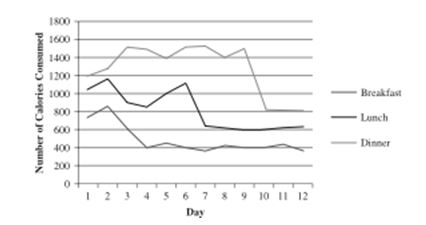Multiple Choice
RESEARCH STUDY 13.3: Dr.Anderson is a nutritionist who helps clients lose weight prior to surgery.She is working with W.J., a male client who is planning on undergoing a heart transplant.He currently eats more than 3,500 calories a day and has been asked by his doctor to cut the number of calories to about 1,800 (400 for breakfast, 600 for lunch, and 800 for dinner) .She is curious as to whether a food journal will help W.J.reduce the number of calories he eats.A food journal is used to record everything a person eats to help patients be more aware of what they're eating.W.J.'s wife also recorded the food he consumed at each meal to have complete data before introducing the journal.Dr.Anderson decides to phase in the food journal gradually, initially only having W.J.record what he ate at breakfast during the first three days after baseline (days 4-6) .During days 7-9, the journal is used at lunch, too, and during days 10-12, it also is used during dinner.The data for Dr.Anderson's study are below.  In interrogating the construct validity of Dr.Anderson's study, which of the following might be asked?
In interrogating the construct validity of Dr.Anderson's study, which of the following might be asked?
A) By what margin did W. J.'s calorie intake improve?
B) How accurate was W. J.'s wife in her calculation of the calories consumed at each meal?
C) Was the number of calories consumed by W. J. going to decrease before surgery anyway?
D) Was Dr. Anderson qualified to analyze the data?
Correct Answer:

Verified
Correct Answer:
Verified
Q7: A wait-list design is helpful in dealing
Q8: Which of the following CANNOT typically be
Q12: Dr. Fletcher is interested in whether joining
Q18: Dr. Fletcher is interested in whether joining
Q23: In quasi-experimental designs, the researcher does not
Q29: Which of the following is a difference
Q30: Lara is conducting a study for her
Q44: Which of the following is a difference
Q53: Layne is trying to watch less television.Her
Q61: Which of the following is a difference